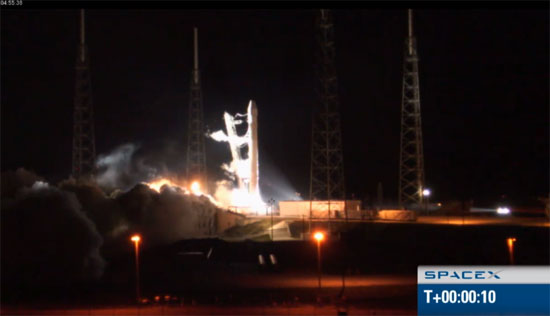SpaceX Mission to International Space Station Aborted at 0.5 Seconds Over Engine Trouble [Updated]
This post has been updated with information from a 6:30 AM NASA press conference.
Today’s 4:55 AM EDT launch of SpaceX’s Dragon spacecraft atop their Falcon 9 rocket was scrubbed with only 0.5 seconds left on the countdown clock when the vehicle’s onboard computer detected that something was amiss. Though all nine engines on the rocket had ignited and flames has started to billow outward, the Falcon 9 stayed on the pad.
During the launch’s livestream, the Kennedy Space Center staff could be heard saying that vehicle’s onboard computer had detected that something was wrong with the Falcon 9’s fifth engine. This was later confirmed by both the KSC twitter and Elon Musk, the founder of SpaceX. Musk wrote:
Launch aborted: slightly high combustion chamber pressure on engine 5. Will adjust limits for countdown in a few days.
In an early morning press conference, SpaceX president Gwynne Shotwell said that Musk’s tweet was based on early information. She said that while the computer did indeed shut down the launch, the software correctly identified that pressure was increasing in engine five.
“We can’t blame the software guys for this one,” joked Shotwell, referencing the software problem that have delayed this flight for several weeks.
During a static fire on April 30 — where the rocket engines were ignited but the vehicle not launched — the computer system also triggered an abort. It was later determined that the computer had been too sensitive and triggered an abort when conditions were still safe. Shotwell said that today’s launch attempt was different, and noted that engine five performed as expected during the static fire.
Interestingly, the Falcon 9 can lose up to two of its engines and still achieve orbit. However, this is not the case during liftoff when all engines must be operating in unison.
At the conclusion of NASA’s official livestream of the event, KSC staff were shutting down and “safeing” the vehicle. Shotwell told reporters later that ground crews were working to drain propellant and other fluids from the rocket, and would begin a physical inspection of engine five around noon today. Because the May 19 launch window was “instantaneous,” SpaceX will not be able to attempt another launch until May 22, 3:45 AM EDT at the earliest.
Shotwell said that the increased pressure in the Falcon’s fifth engine was possibly caused by increasing temperature from a lack of fuel. This means that repairs to the rocket may be necessary before another launch can be attempted. Shotwell went on to say that SpaceX has a second Falcon 9 rocket at Cape Canaveral and could swap out the misbehaving rocket engine as a measure of last resort.
Such a drastic repair would be time consuming, but SpaceX apparently has good launch windows every three days — depending on the position of the International Space Station.
Had it been successful, today’s launch would have been the first time a commercial vehicle took off to dock with the ISS. The Dragon spacecraft had already been prepared with 1,200 pounds of non-essential cargo — including food, clothing, and science experiments designed by school children. If it had launched, the Dragon would have performed a series of maneuvers around the space station before berthing with the orbiting outpost. The mission was planned to end with the Dragon splashing down in the Pacific ocean several days later.
The abort is a setback for SpaceX, which had already been contracted by NASA to perform a dozen unmanned resupply missions to the ISS for a reported $1.6 billion. This morning’s mission, called COTS Demo 2, was separate from those resupply missions.
Though discouraging, Shotwell stressed that today’s launch was not a failure. “We aborted with purpose,” she told reporters. Despite being loaded with cargo, this was a flight test designed for both SpaceX and NASA to gain insight for future missions.
Launching rockets is tricky business, and hopefully what’s learned from today’s abort will mean the next launch attempt goes off without a hitch.
- Here’s what the inside of a manned Dragon might look like
- A review of all SpaceX’s Dragon capsules
- Here’s how the United States will return to space
Have a tip we should know? tips@themarysue.com
